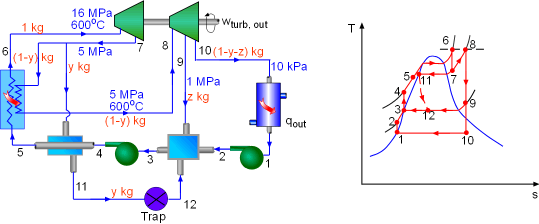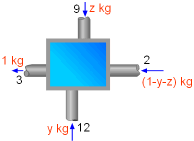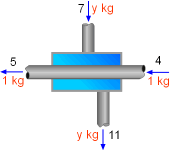| Ch 10. Rankine Cycle | Multimedia Engineering Thermodynamics | ||||||
|
Rankine Cycle |
Reheat | Regeneration | Cogeneration | ||||
| Ideal Regenerative Rankine Cycle | Case Intro | Theory | Case Solution |
| Chapter |
| 1. Basics |
| 2. Pure Substances |
| 3. First Law |
| 4. Energy Analysis |
| 5. Second Law |
| 6. Entropy |
| 7. Exergy Analysis |
| 8. Gas Power Cyc |
| 9. Brayton Cycle |
| 10. Rankine Cycle |
| Appendix |
| Basic Math |
| Units |
| Thermo Tables |
| eBooks |
| Dynamics |
| Fluids |
| Math |
| Mechanics |
| Statics |
| Thermodynamics |
| ©Kurt Gramoll |
|
|
||
|
A steam power plant operates on an ideal reheat-regenerative Rankine cycle with one open feedwater heater, one closed feedwater heater, and one reheater. The fractions of stream extracted from turbines and the thermal efficiency of the cycle are to be determined. Assumptions:
|
||
 Schematic of the Power Plant and Its T-s Diagram |
||
|
Saturated Water Temperature Table Saturated Water Pressure Table Superheated Steam Table |
(1) Determine the fraction of steam extracted from the turbines The enthalpies at various states and the pump work per unit mass of fluid flowing through them can be determined by using the water tables. State1: saturated water State 2: compressed water State 3: saturated water State 4: compressed water State 5: saturated water |
|
State 6: superheated vapor State7: superheated vapor State 8: superheated vapor State 9: superheated vapor State 10: saturated mixture State 11: saturated water State 12: The trap is an throttling device |
||
|
|
Assume y kg steam is extracted from the high-pressure turbine per kg mass of water flowing through the boiler. Also assume z kg steam is extracted from the low-pressure turbine per kg mass of water flowing through the boiler. Then y and z can be determined from the energy balance of the closed and open feedwater heaters. Closed feedwater heater: Open feedwater heater: (2) Determine the thermal efficiency of the cycle The power output from the high-pressure and low-pressure turbine for 1 kg of mass flowing through the boiler is: wturb,out = (1)(h6 -
h7) + (1 - y)(h8 - h9) The pump input works have been determined in (1) as wpump,in = (1 - y -z)1.0 + 16.9 So the total net work output fro 1 kg mass of water flowing through the boiler is The total heat input to the cycle equals the sum of the heat input in the boiler and the heat input from the reheater. qin = (1)(h6 -
h5) + (1 - y)(h8 - h7) The thermal efficiency is |
|

